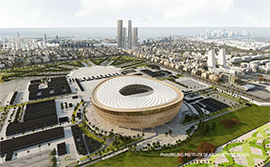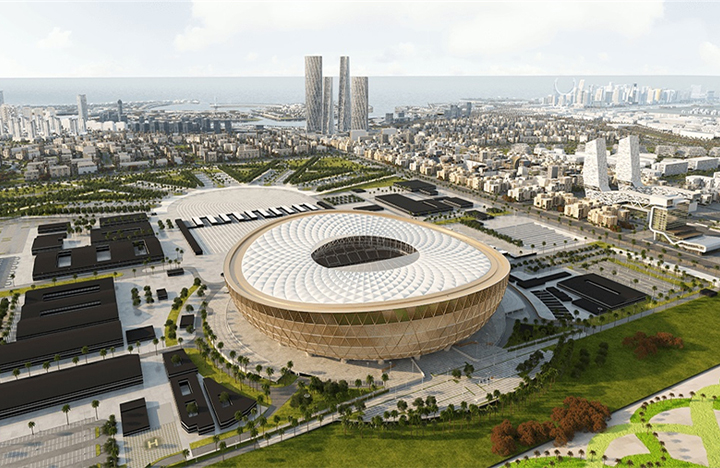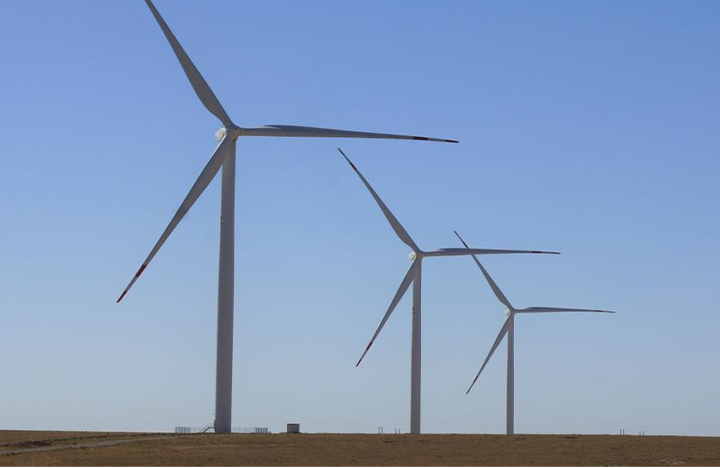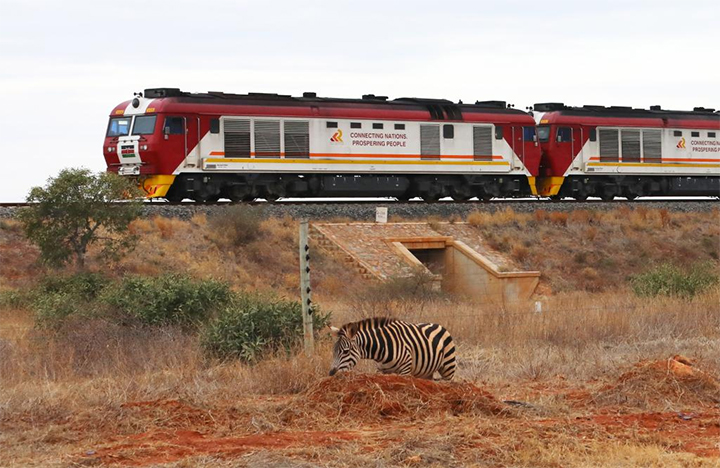


In his keynote speech at the opening ceremony of the third Belt and Road Forum for International Cooperation, President Xi Jinping announced eight actions for China to support high-quality jointly build the Belt and Road Initiative, one of which is “promoting green development.” Specific measures include, “China will continue to deepen cooperation in green infrastructure, green energy, green transportation and other fields.” This article will introduce how China and the world are exploring innovation and win-win cooperation in the field of green infrastructure, and how the concept of green, low-carbon and sustainable development is becoming a reality.
From the process of accelerating the construction of a modern infrastructure system in China to the jointly build the “Belt and Road”, a common phenomenon is that "green" is becoming an increasingly distinctive color in infrastructure construction. From small-scale projects to large-scale projects, from China to the world, green infrastructure is gaining more and more favor. China’s years of construction experience have also been “go global” in the process of jointly building the “Belt and Road”, benefiting more and more countries and regions.
PART1: Green Innovation Experience “Going Global”
On October 11, the main structure of the water inlet tower of the Ma’erdang Hydro-power Station, the highest hydro-power station under construction in the Yellow River Basin with the highest installed capacity and the highest installed capacity, was successfully capped. Deep in the mountains and canyons of Maqin County, Goluo Tibetan Autonomous Prefecture, Qinghai Province, the Ma’erdang Hydro-power Station with a dam height of 211 meters, a total installed capacity of 2.32 million kilowatts, and a total storage capacity of 1.622 billion cubic meters is rising. The hydro-power station has an average annual power generation capacity of 7.304 billion kilowatt hours. Once fully put into operation, it can save 2.56 million tons of standard coal and reduce carbon dioxide emissions by 8.16 million tons every year.
In the opinion of experts, China's green innovation advantages can play a great role in jointly building the “Belt and Road”. Chen Xiangsheng, an academician of the CAE Member, said that infrastructure construction in mainland China is moving towards green, carbon reduction and resilience construction, especially in green and near zero carbon emission energy utilization, leading the transformation of the world's energy utilization and development model, widely applied in the “Belt and Road” infrastructure construction, benefiting the host country, and making China's contribution to promoting the construction of a community with a shared future for mankind. He believed that the infrastructure construction industry should uphold the concept of harmonious coexistence between man and nature, green transformation, high-quality development, and biodiversity protection, and develop along the path of carbon peak and carbon neutrality.
On the other side of the Himalayas, the Chinese experience not only goes out, but also gets recognition. On September 3, the Nepal KK Highway Project of China Railway Second Bureau was awarded the honorary title of “Best Environmental Protection Monitoring Team” by the Ministry of Finance of Nepal and the Asian Development Bank. It is understood that the Nepal KK Highway Project is a rehabilitation project for existing roads. Due to differences in national conditions, there are also differences in relevant environmental protection requirements. Therefore, the Chinese project department has done a lot of work. For example, after organizing forces to conduct research and planning, the Chinese project department issued a construction environmental assessment report together with the local government and supervision; for example, based on the actual situation of the construction site, the environmental protection plan, environmental protection system, soil and water conservation and cultural relic protection system and other system documents have been formulated successively; for example, a special environmental management group has been established, and 5 local Nepalese environmental engineers have been hired for environmental management. Due to these detailed preparations, since the start of the project, the project has repeatedly received environmental inspections from various levels of government and ADB's environmental protection departments in Nepal, and all received positive comments.
PART2: Green Infrastructure Projects Spread All Over The World
In the process of jointly building the "the Belt and Road", green infrastructure projects with Chinese participation are blooming everywhere. In the past decade, Chinese companies have completed more than 3,000 infrastructure projects in countries along the “Belt and Road”, many of which are green energy, green transportation and green building projects.
In Laos, the China-Laos Railway, which started operation in December 2021, has set a benchmark for green and sustainable infrastructure projects and spread the concept of green trade and cooperation.
In Qatar, the Lusail Stadium, the venue for the 2022 World Cup finals, not only allows global audiences to be intoxicated with the charm of football, but also demonstrates the miracle of building a high-quality, environmentally friendly building in a desert area. This modern stadium adopts a number of environmentally friendly and energy-saving innovative technologies, uses recyclable materials, and saves 40% of fresh water compared to traditional construction stadiums.

Lusail Stadium located in Doha, Qatar [Photo/BEIJING INSTITUTE OF ARCHITECTURE DESIGN]
In Senegal, China's participation in the Dakar Han Bay sewage treatment project will greatly improve the ecological environment and residents' living environment along the Dakar Bay, reduce sewage-related infectious diseases in the area, and benefit hundreds of thousands of people.
In Ghana, as the units of the Sheneng Ansuogu Power Plant invested and constructed by China in Ghana have been put into operation, green and clean energy has begun to alleviate the electricity shortage of the local people.
In Kazakhstan, new energy projects such as the Zhanatas Wind Farm and the Turgusun Hydropower Station in which Chinese companies participated in the construction have helped the local transition to low carbon.

Wind turbines at Zhanatas wind farm in Kazakhstan [Photo/Xinhua]
In Uzbekistan, the Uzbekistan Syr Darya 1500MW gas-fired combined cycle power station project participated in the construction of China Construction Fifth Engineering Group Co., Ltd. is entering a critical node. The power station adopts a gas turbine with the highest combustion temperature, largest unit power and highest efficiency in the world and a “zero wastewater discharge” design scheme. It is also a world-leading green energy-saving and environmentally friendly project. According to reports, after completion, this project can provide more than 36 million kilowatt-hours of electricity every day, which can greatly alleviate the problem of power shortage in Uzbekistan and promote green development.
There are countless examples like this, which prove the green development concept vigorously advocated by China. It can not only help improve the local natural environment, but also provide solutions for reducing environmental pollution, making solid contributions to promoting world environmental governance. Through jointly building the “Belt and Road” green development project, a virtuous circle of economic growth and environmental protection in the countries along the “Belt and Road” has been achieved, contributing to local sustainable development, and promoting the global move towards a more low-carbon future.
PART3: Solve Real Problems For The Country Where The Project Is Located
Two details are impressive.
First, in Kenya, the Mombasa-Nairobi Railway connecting Nairobi, the capital of Kenya, and Mombasa, the largest port in East Africa, has a specially designed bridge for the migration of wild animals. Even giraffes can pass through the bridge opening with a height of more than 7 meters.

On July 28, 2022, a zebra grazed near the Mombasa-Nairobi Railway in Tsavo, Kenya [Photo/Xinhua]
The second is the Red Sea public infrastructure project located in Tabuk Province in western Saudi Arabia. As a key project in Saudi Arabia’s “Vision 2030”, it is the largest off-grid energy storage project in the world. In the construction of the power transmission network between islands, the submarine automatic robots from China were launched for operation, and strict environmental protection measures were taken to minimize the impact on marine life; while several "sewage treatment plants" composed of artificial wetlands realized the recyclable use of domestic sewage in the new city.
From allowing giraffes to pass through without any difficulty to using underwater robots to carry out operations, we are only trying to solve real problems during the construction process. Pragmatism has become a distinctive feature of China's green infrastructure in the “Belt and Road”.
A typical example is the Karot Hydropower Station built in Pakistan.
In terms of solving energy problems, the Karot Hydropower Station can provide about 3.2 billion kWh of clean electricity every year, which can meet the electricity demand of about 5 million people. It is estimated that 3.5 million tons of carbon dioxide emissions can be reduced every year.
In terms of solving ecological problems, in order to protect the country's characteristic fish, Chinese staff conducted a special investigation and strictly formulated fish protection measures, providing clean fuel for the local people while effectively maintaining the diversity of local flora and fauna.
In terms of employment, the project vigorously advocates localized management. According to statistics, more than half of the construction team of the Karot Hydropower Station is made up of local Pakistani employees, which can provide nearly 2,300 jobs for the local community during the peak construction period. The Chinese company has also implemented a "livelihood recovery plan", providing free financial literacy training and skills training in electrical engineering, plumbing, car driving, etc. for affected immigrants over the age of 16.
PART4: Share Chinese Wisdom In Common Development
In the process of building the “Belt and Road”, China has always adhered to the principle of ecological priority, thus continuously promoting the improvement of the global environmental governance system.
On the basis of positive progress in green and low-carbon development, China has promised not to build new overseas coal power projects, actively construct a green financial development platform and an international cooperation mechanism, carry out cooperative research on biodiversity conservation with co construction countries, jointly maintain the ecological security of the Maritime Silk Road, build the “Belt and Road” ecological and environmental protection big data service platform and the “Belt and Road” environmental technology exchange and transfer center, Implement the Green Silk Road Messenger Plan.
Taking talent training as an example, China actively supports countries along the “Belt and Road” to strengthen the cultivation of green talents and has implemented the Green Silk Road Envoy Program. As of the beginning of 2023, it has trained 3,000 people for more than 120 countries along the “Belt and Road”.
Not long ago, the garbage transfer station projects on Malé Island and Villimalé Island in the Maldives, which were constructed by China State Construction Engineering Corporation, completed their completion acceptance. It is understood that due to geographical conditions, the domestic waste in the capital Male' area of Maldives must first be collected through garbage transfer stations, then transported by ship to garbage islands for incineration and landfill treatment. However, the original garbage transfer stations have narrow sites and single functions, without container transportation and other modern transfer capabilities. After the project is put into production, it will effectively solve the problems of garbage classification and transfer in Malé Island and Villimalé Island, providing a solid guarantee for Maldives to use garbage power generation in the future. It is expected that the daily comprehensive garbage treatment capacity will reach 150 tons, and about 260 tons of marine garbage emissions can be reduced every year, which is of far-reaching significance to protect the local ecological environment.
Source: <http://finance.people.com.cn/n1/2023/1108/c1004-40113195.html>
<https://www.yidaiyilu.gov.cn/p/0V4F617H.html>
Edited and Translated by Lu Yufei